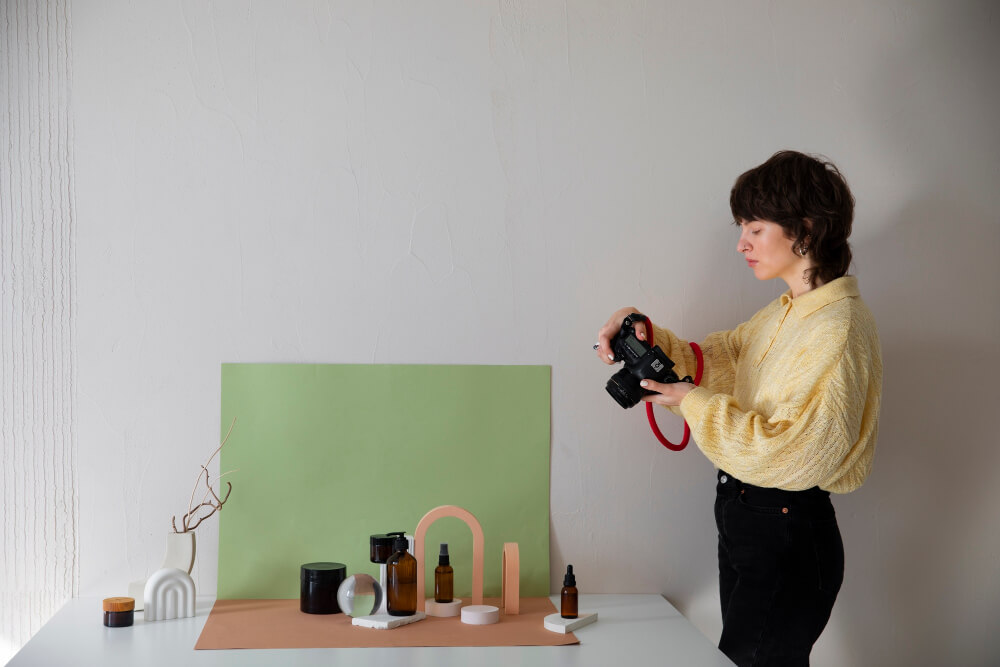For E-commerce to succeed in 2024, high-quality images are an absolute necessity. But where do you begin? This blog post will equip you with the foundational principles of product photography, empowering you to capture stunning visuals that showcase your products in their best light.
Why Product Photography Matters
Product photography is the cornerstone of effective product marketing. It’s the first impression potential customers have of your offerings, and can significantly influence their buying decisions. High-quality images:
- Grab Attention: Compelling product photos entice customers to stop scrolling and click on your product listings.
- Drive Sales: Clear, detailed images build trust and confidence, ultimately leading to more sales conversions.
- Enhance Brand Image: Professional product photography reflects a brand’s professionalism and attention to detail.
The Essentials in Your Product Photography Kit
Before diving in, ensure you have the right tools for the job:
- Camera: A DSLR or mirrorless camera offers superior image quality compared to smartphones. Invest in a camera with manual controls to achieve the desired results.
- Lighting: Lighting is paramount! Natural light is ideal, but artificial lighting setups using softboxes, strobes, or LED panels offer more control.
- Backgrounds and Surfaces: Choose a clean, wrinkle-free background that complements your products. Solid colors, textured surfaces, or natural elements like wood can all be effective.
Mastering Composition and Framing
- Rule of Thirds: Imagine dividing your frame into a grid of nine squares. Position your product at one of the intersecting points to create a more visually pleasing composition.
- Framing: Experiment with different framing techniques. Filling the frame with your product creates a bold statement, while negative space can add a sense of minimalism.
- Angles: Don’t just stick to eye level! Explore different angles to showcase your product’s dimensions and key features. Capture close-up shots to highlight details, and overhead shots for products with a flat layout.
Styling and Arranging Your Products
- Cleanliness is Key: Ensure your products are dust-free and blemish-free before photographing. Presentation matters!
- Props and Accessories: Strategically use props and accessories to enhance product styling and demonstrate functionality. Just avoid overwhelming the product itself.
- Consistency is King: Maintain a consistent style and arrangement throughout your product photos. This creates a cohesive visual experience for your customers.
Lighting Techniques: Natural vs. Artificial
- Natural Light: Soft, diffused natural light creates a natural and inviting look. However, it can be unpredictable and requires careful planning.
- Artificial Lighting: Artificial lighting setups offer more control over lighting conditions. Experiment with softboxes for diffused light, strobes for dramatic effects, or LED panels for continuous lighting.
- Light Modifiers: Diffusers soften harsh light, while reflectors bounce light to brighten shadows. Mastering light modifiers will elevate your product photography game.
Editing and Post-Processing Basics
- Software Options: Popular editing software like Adobe Photoshop and Lightroom offer powerful tools for enhancing your images.
- Basic Editing Techniques: Adjust exposure for optimal brightness, white balance for accurate color reproduction, and crop the image for better composition.
- Retouching: Retouching can remove minor imperfections, but avoid going overboard. The goal is to enhance, not misrepresent, your products.
Tips for Success: Practice Makes Perfect
- Planning and Preparation: Plan your photoshoot beforehand, including lighting setups, product placement, and desired effects.
- Practice and Experimentation: Don’t be afraid to experiment! The more you practice, the more comfortable and confident you’ll become with different techniques.
- Continuous Learning: The world of product photography is constantly evolving. Stay updated with the latest trends and techniques to keep your skills sharp.
Conclusion
By understanding these foundational principles and putting them into practice, you’ll be well on your way to capturing captivating product photos that convert browsers into buyers. So, grab your camera, experiment with lighting, and unleash your creativity! Remember, the key is to start, keep practicing, and refine your skills over time. With dedication, you’ll be mastering the art of product photography in no time.




